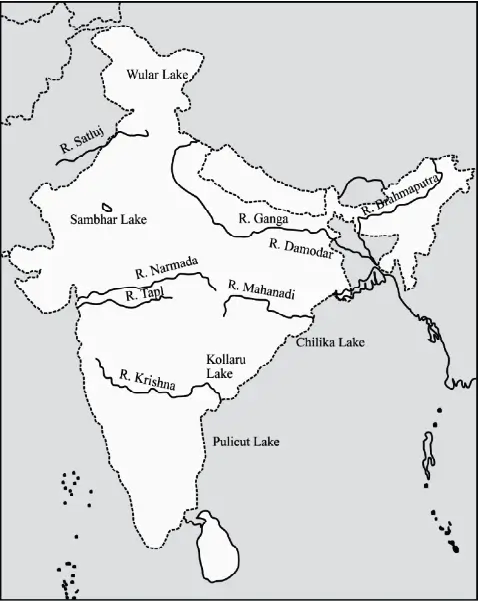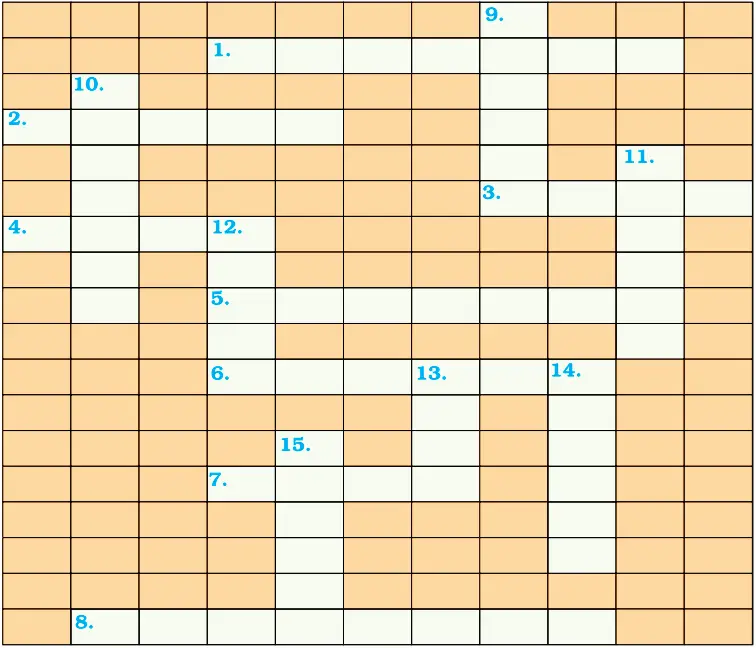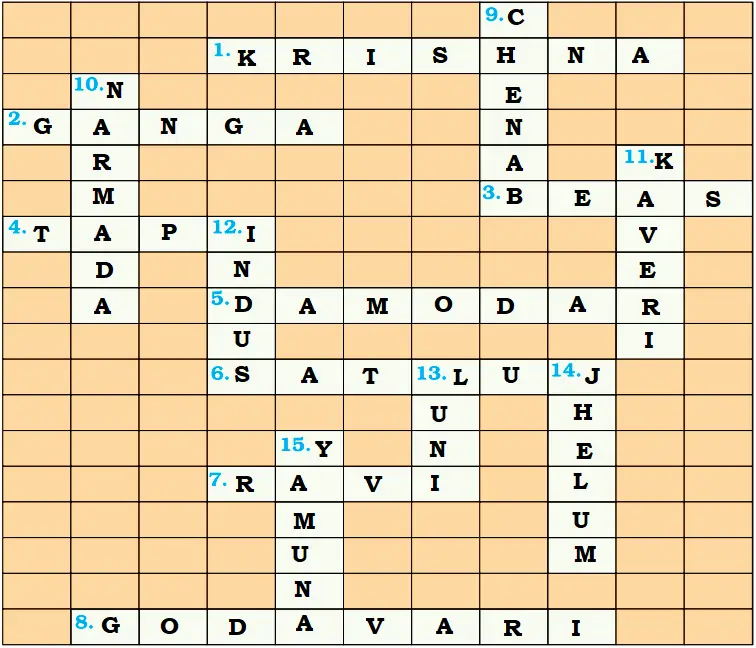NCERT Solution for Class 9 Geography Chapter 3 Drainage
Intext - Questions
Find Out - 1
Question.1. Which river has the largest basin in India?
Ans. The largest basin in India is of the Ganga river with a drainage area of 8,62,769 sq. km.
Find Out - 2
Question.1. Find out the name of the biggest waterfall in India.
Ans. The highest waterfall in India is on the Varahi river in Shimoga district of Karnataka.
The name of the waterfall is Kunchikal Falls and its height is 455 metres (1,493 ft).
Activity
Question.1. Make a list of natural and artificial lakes with the help of the atlas.
Ans.
Natural Lake | Artificial lake |
(a) Wular lake | (a) Gobind sagar |
(b) Dal lake | (b) Rana Pratap sagar |
(c) Nainital lake | (c) Nizam sagar |
(d) Bhimtal lake | (d) Nagarjuna sagar |
(e) Loktok lake | (e) Hirakud |
(f) Barapani lake | |
(g) Chilka lake | |
(h) Sambhar lake | |
(i) Pulicat lake | |
(j) Kolleru lake | |
(k) Vembanad lake |
Exercise
Question.1. Choose the right answer from the four alternatives given below:
(i) Which one of the following describes the drainage patterns resembling the branches of a tree?
(a) Radial
(b) Dendritic
(c) Centrifugal
(d) Trellis
Answer
(b) Dendritic
(ii) In which of the following states is the Wular Lake located?
(a) Rajasthan
(b) Punjab
(c) Uttar Pradesh
(d) Jammu and Kashmir
Answer
(d) Jammu and Kashmir
(iii) The river Narmada has its source as
(a) Satpura
(b) Amarkantak
(c) Brahmagiri
(d) Slopes of the Western Ghats
Answer
(b) Amarkantak
(iv) which one of the following lakes is a salt water lake?
(a) Sambhar
(b) Wular
(c) Dal
(d) Gobind Sagar
Answer
(a) Sambhar
(v) Which one of the following is the longest river of peninsular India?
(a) Narmada
(b) Krishna
(c) Godavari
(d) Mahanadi
Answer
(c) Godavari
(vi) Which one amongst the following rivers flow through a Rift Valley?
(a) Mahanadi
(b) Krishna
(c) Tungabhadra
(d) Tapi
Answer
(d) Tapi
Question.2. Answer the following questions briefly.
(i) What is meant by a water divide? Give an example?
Ans. Any elevated area such as a mountain or an upland that separate two drainage basins is called a water divide. An example are the Western Ghats.
(ii) Which is the largest river basin in India?
Ans. The Ganga Basin is the largest river basin in India.
(iii) Where do the rivers Indus and Ganga have their origin?
Ans. The river Indus rises in Tibet, near lake Mansarowar, and the Ganga originates at the Gangotri Glacier. Both of them have their origin in the Himalayas.
(iv) Name the two headstreams of the Ganga. Where do they meet to form the Ganga?
Ans. The two headstreams of the Ganga are the Bhagirathi and Alaknanda. They meet at Devaprayag in Uttarakhand to form the Ganga.
(v) Why does the Brahmaputra in its Tibetan part have less silt, despite a longer course?
Ans. In Tibet, the river Indus known as Tsang Po carries a smaller volume of water and less silt as it is a cold and dry area.
In India, the river carries a large volume of water and considerable amount of silt because it passes through a region of high rainfall.
(vi) Which two peninsular rivers flow through a trough?
Ans. Narmada and Tapi are two peninsular rivers, which flow through a trough.
(vii) State some economic benefits of rivers and lakes.
Ans. Economic benefits of Lakes:
- Lakes are of a great value to human beings.
- Lakes help to regulate the flow of rivers.
- Lakes help to prevent flooding during rainy season.
- During the dry season, lakes help to maintain an even flow of water.
- Lakes can also be used for developing hydel power.
- They moderate the climate of the surroundings and maintain the aquatic eco-system.
- They enhance natural beauty and help to develop tourism and provide recreation. e.g., Dal Lake and Naini Lake at Nainital.
- Lakes provide opportunities for fishery development.
Economic benefits of Rivers:
- They help to develop hydel power.
- They provide water for irrigation, for drinking and other requirements.
- They help to develop fisheries.
Question.3. Below are given names of a few lakes of India. Group them under two categories natural and created by human beings.
(a) Wular
(b) Dal
(c) Nainital
(d) Bhimtal
(e) Gobind Sagar
(f) Loktak
(g) Barapani
(h) Chilka
(i) Sambhar
(j) Rana Pratap Sagar
(k) Nizam Sagar
(l) Pulicat
(m) Nagarjuna Sagar
(n) Hirakud
Ans.
Man-made Lakes | Natural Lakes |
Gobind Sagar | Wular |
Rana Pratap Sagar | Dal |
Nizam Sagar | Nainital |
Nagarjuna sagar | Bhimtal |
Hirakud | Loktak |
Barapani | |
Chilka | |
Sambhar | |
Pulicat |
Question.4. Discuss the significant difference between Himalayan and the peninsular rivers.
Ans. Difference between the Himalayas and Peninsular rivers are as the follows:
Himalayan Rivers | Peninsular Rivers |
(1) Himalayan rivers are perenial and flow the throughout the year. | (1) A large number of peninsular rivers are seasonal and flow during a certain period in a year. |
(2) They receive water from rainfall and melting snow of the mountains and glaciers. | (2) They receive water from rainfall only. |
(3) The Himalayan rivers have long courses. | (3) The peninsular river have short and shallow courses. |
(4) They carry a lot of silt and sand. | (4) They carry very less or no silt and sand. |
(5) These rivers originate from the North of the Himalayan mountain ranges. | (5) They mainly originate in the Western Ghats. |
(6) Their drainage basins are large. | (6) Their drainage basins are small. |
(7) These rivers form big deltas. | (7) They form small deltas. |
(8) They are useful for irrigation, cultivation and navigation. | (8) They are seasonal and flow over rocky areas and are not useful for cultivation and navigation. |
Question.5. Compare the east flowing and west flowing rivers of the Peninsular plateau.
Ans. The difference between east flowing rivers and west flowing rivers are as follow:
East Flowing Rivers | West Flowing Rivers |
(1) These rivers originate from the Western Ghats and flow eastwards. | (1) These rivers originate in central India and flow westwards. |
(2) These rivers flow into the Bay of Bengal. | (2) These rivers flow into the Arabian Sea. |
(3) These rivers form deltas at their mouths. | (3) These rivers form estuaries at their mouths. |
(4) They carry larger amount of water. | (4) They carry a lesser amount of water. |
(5) Examples are Mahanadi, Godavari, Krishna and Kaveri. | (5) Examples are : Narmada and Tapi. |
Question.6. Why are rivers important for the country’s economy?
Ans. Rivers are important for the country’s economy because water from the rivers is a basic natural resource essential for various human activities. These are:
- The rivers provide water for irrigation.
- They provide fertility to the soil.
- They are useful for navigation.
- They help to generate hydro-electricity.
- They help to develop tourism.
- They provide water for various domestic uses.
- They provide livelihood to fishermen.
- They help to moderate the climate and environment of nearby areas.
Map Skills
Question.1. (i) On an outline map of India mark and label the following rivers: Ganga, Satluj, Damodar, Krishna, Narmada, Tapi, Mahanadi, and Brahmaputra.
(ii) On an outline map of India mark and label the following lakes: Chilika, Sambhar, Wular, Pulicut, and Kolleru.
Ans.
Project/Activity
Solve this crossword puzzle with the help of given clues.
Across
1. Nagarjuna Sagar is a river valley project. Name the river?
2. The longest river of India.
3. The river which originates from a place known as Beas Kund.
4. The river which rises in the Betul district of MP and flows westwards.
5. The river which was known as the “Sorrow” of West Bengal.
6. The river on which the reservoir for Indira Gandhi Canal has been built.
7. The river whose source lies near Rohtang Pass.
8. The longest river of Peninsular India?
Down
9. A tributary of Indus originating from Himachal Pradesh.
10. The river flowing through fault, drains into the Arabian Sea.
11. A river of south India, which receives rainwater both in summer and winter.
12. A river which flows through Ladakh, Gilgit and Pakistan.
13. An important river of the Indian desert.
14. The river which joins Chenab in Pakistan.
15. A river which rises at Yamunotri glacier.
Ans.
Across:
1. Krishna
2. Ganga
3. Beas
4. Tapi
5. Damodar
6. Satluj
7. Ravi
8. Godavari
Down:
9. Chenab
10. Narmada
11. Kaveri
12. Indus
13. Luni
14. Jhelum
15. Yamuna







